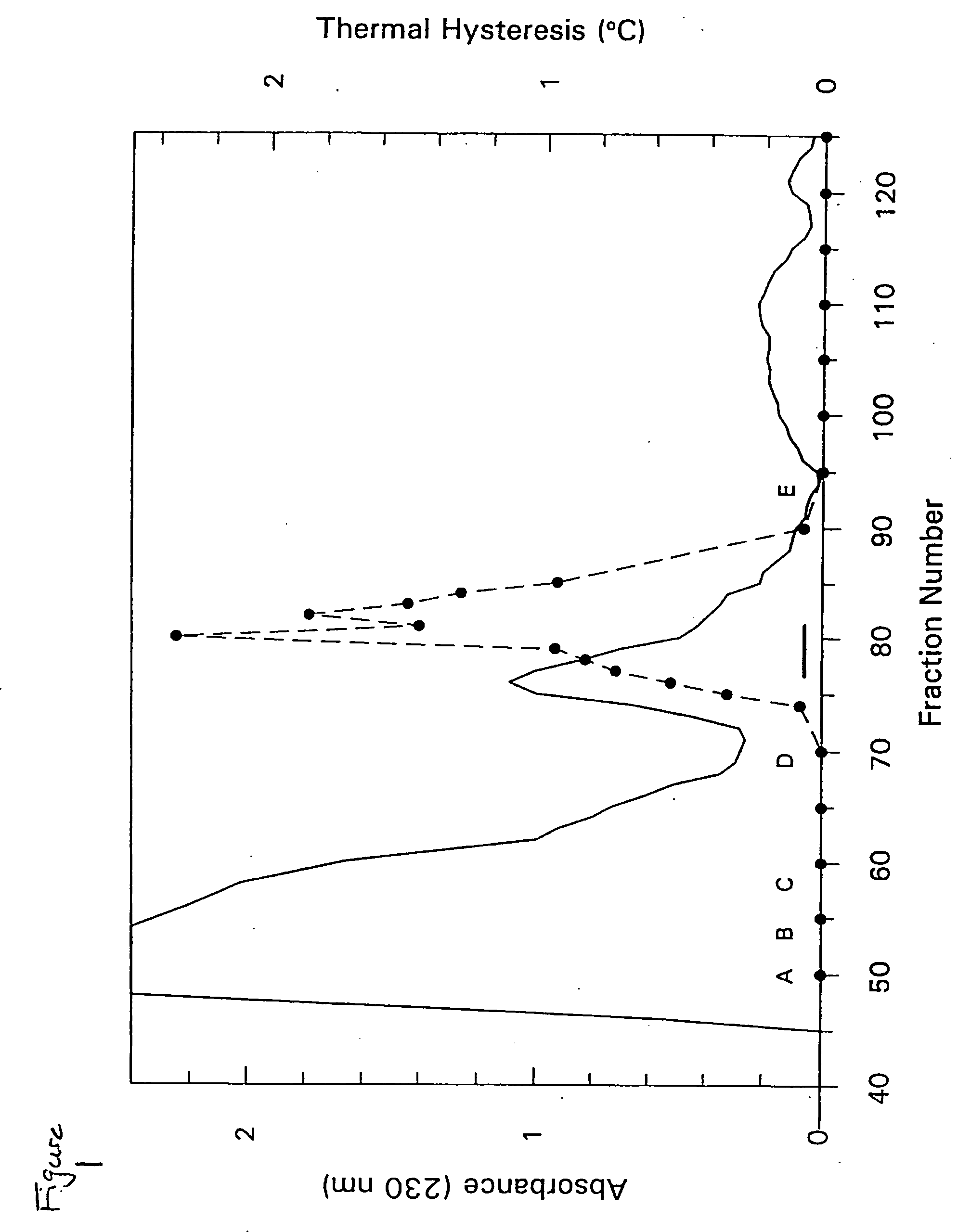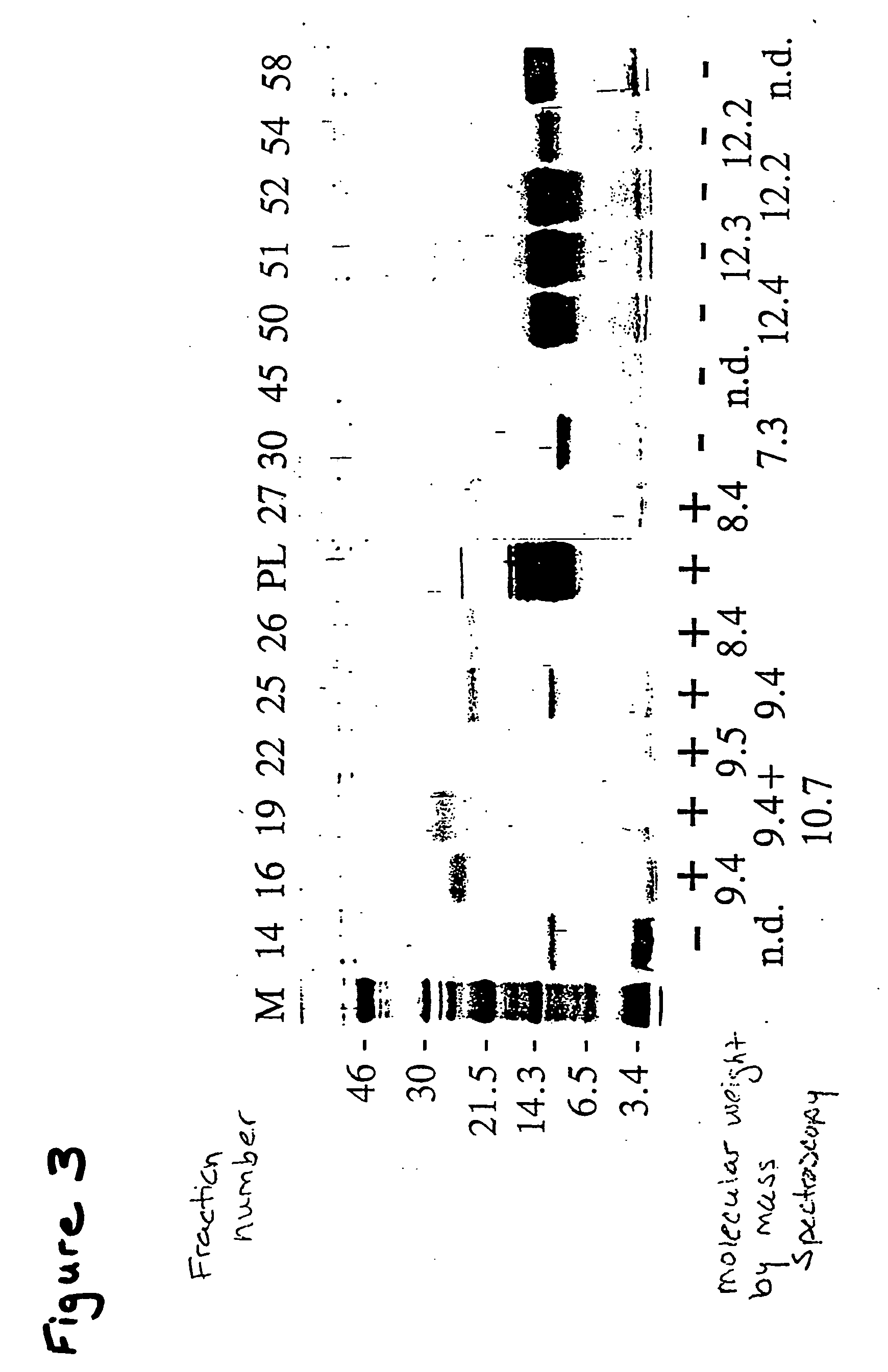Tenebrio antifreeze proteins
- Summary
- Abstract
- Description
- Claims
- Application Information
AI Technical Summary
Benefits of technology
Problems solved by technology
Method used
Image
Examples
example 1
THP from Tenebrio molitor Larvae
[0207] The following example details the isolation of THP from the hemolymph of Tenebrio molitor. Tenebrio molitor larvae were reared as previously described (see, Graham, et al., Insect Biochem. Molec. Biol. 26:127 (1996)) but in darkness. Hemolymph (600 μL) was obtained from exudates at severed prolegs of 100 presumed final instar larvae and diluted 1:1 in ice-cold hemolymph buffer (50 mM Tris-HCl (pH 8.0), 150 mM NaCl and 1 mM phenylthiocarbamide.
[0208] Diluted hemolymph (1.2 mL) was loaded onto an S-100 SEPHACRYL® (Pharmacia) column (92 cm×1.6 cm) and eluted with hemolymph buffer without phenylthiocarbamide. Selected active fractions were combined and chromatographed by reversed-phase HPLC on a C18 analytical column (Vidac), using a gradient of 0.4% acetonitrile / min in 0.05% trifluoroacetic acid. Fractions were lyophilized and resuspended in 50 μL of 0.1 M NH4HCO3 (pH 8.0) for TH measurements following standard procedures (see, Chakrabarrty & He...
example 2
cDNA Library Screening for THP-Encoding Genes
[0212] To isolate other isoforms of tile THP of this invention, oligonucleotides for probes (SEQ ID NOs:2 and 5), PCR primers (SEQ ID NOs: 6 and 7) and sequencing primers (SEQ ID NOs: 8 and 9) were designed based on the consensus sequence determined from sequencing TH positive clones (YL-1-4).
[0213] Aliquots of a Tenebrio molitor larval fat body λ-Zap cDNA library (see, Graham, et al., Insect Biochem. Molec. Biol. 26:127 (1996)) were screened with the nucleic acid sequence of YL-1 from the 5′ end to the stop codon (SEQ ID NO: 16). Approximately 1×105 plaques were screened at moderate stringency following standard methodologies using the sequence listed above. Isolated positive plaques were subjected to in vivo excision using R408 helper phage (Stratagene) as per manufacturer's instructions. The double-stranded DNA obtained was purified and sequenced as above using the vector primers T7 and T3 as well as SEQ ID NOs:8 and 9.
[0214] The co...
example 3
Subcloning and Protein Expression
[0215] PCR linker-primers (SEQ ID NO: 6 and 7) were designed to amplify the THP coding region and to introduce a Met codon before the presumed N-terminal residue of the mature protein. The resulting fragment was ligated into the pET-20b(+) vector (Novagen) and transformed into E. coli BL21(DE3). Expression was induced using isopropyl β-D-thiogalactopyranoside, cells were harvested by centrifugation, and sonicated in 10 mM Tris-HCl (pH8.0), 1 mM EDTA, 0.1 mM phenylmethylsulfonyl fluoride. Cleared supernatant was loaded onto a G75 gel exclusion chromatography column. Active fractions were pooled, lyophilized, resuspended in 50 mM Tris-HCl (pH 8.0), and dialyzed overnight against the same buffer.
PUM
| Property | Measurement | Unit |
|---|---|---|
| Temperature | aaaaa | aaaaa |
| Temperature | aaaaa | aaaaa |
| Concentration | aaaaa | aaaaa |
Abstract
Description
Claims
Application Information
 Login to View More
Login to View More - R&D
- Intellectual Property
- Life Sciences
- Materials
- Tech Scout
- Unparalleled Data Quality
- Higher Quality Content
- 60% Fewer Hallucinations
Browse by: Latest US Patents, China's latest patents, Technical Efficacy Thesaurus, Application Domain, Technology Topic, Popular Technical Reports.
© 2025 PatSnap. All rights reserved.Legal|Privacy policy|Modern Slavery Act Transparency Statement|Sitemap|About US| Contact US: help@patsnap.com



